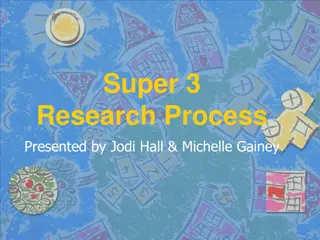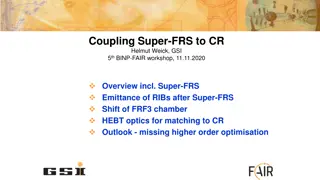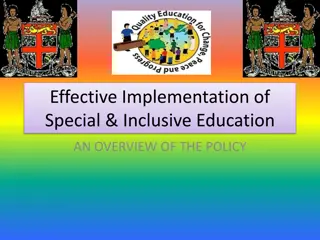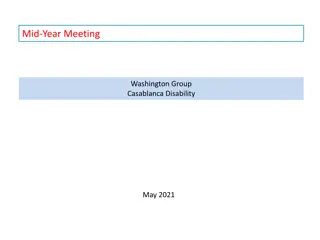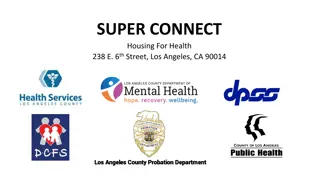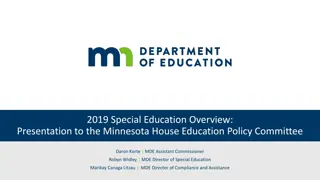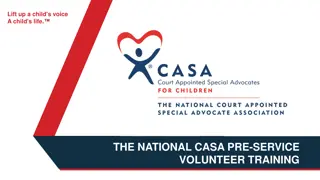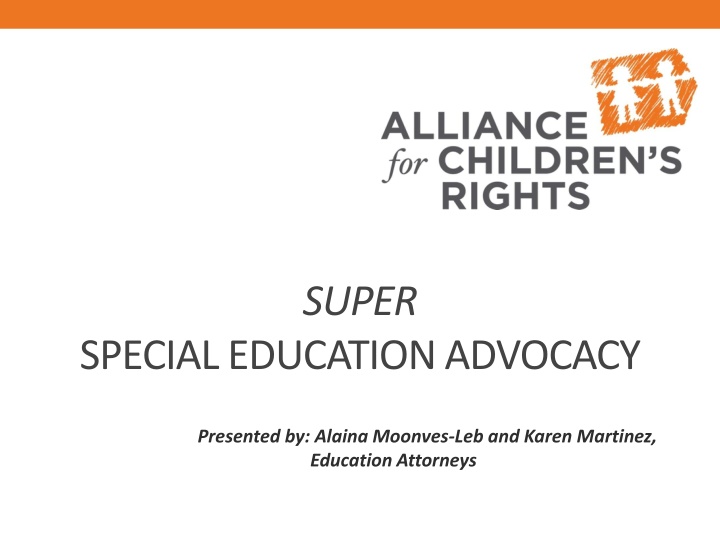
Special Education Advocacy for Students with Disabilities
Explore the essential aspects of special education advocacy for students with disabilities, including warning signs, behavior management, placement options, IEP complications, and disciplinary considerations. Learn about the rights and responsibilities of Education Rights Holders in making education-related decisions for students.
Download Presentation

Please find below an Image/Link to download the presentation.
The content on the website is provided AS IS for your information and personal use only. It may not be sold, licensed, or shared on other websites without obtaining consent from the author. If you encounter any issues during the download, it is possible that the publisher has removed the file from their server.
You are allowed to download the files provided on this website for personal or commercial use, subject to the condition that they are used lawfully. All files are the property of their respective owners.
The content on the website is provided AS IS for your information and personal use only. It may not be sold, licensed, or shared on other websites without obtaining consent from the author.
E N D
Presentation Transcript
SUPER SPECIAL EDUCATION ADVOCACY Presented by: Alaina Moonves-Leb and Karen Martinez, Education Attorneys
WHAT ARE WE GOING TO TALK ABOUT?
Overview Quick Review: Special Education Basics For more, see Special Education presentation slides . What are the warning signs that a student might need a higher level of special education services? (Internal and External) What can you do if a student has higher-level behavior or mental health needs at school? (FBA, BSP, ERMHS) What are the different placement options for students with high levels of special education needs? (NPS, Residential Placement) Common Complications in IEPs (Consent, Moving, Residency) What if a student with special education needs gets involved in school discipline? (Suspensions, Expulsions, Manifestation Determinations, Interim Alternative Educational Placements)
REVIEW: WHAT IS SPECIAL EDUCATION?
Special Education Students with disabilities have a right to special education and related services. These are described in an Individualized Education Program ( IEP ). This is an education program that is individualized to meet the student s unique needs based on their disability. FAPE: Free Appropriate Public Education The disability must prevent the student from benefiting from their education. Related Services are such developmental, corrective, and other supportive services as may be required to assist a child with a disability to benefit from special education .
REVIEW: WHO HAS THE LEGAL AUTHORITY TO MAKE EDUCATION DECISIONS?
What are education rights? An Education Rights Holder (ERH) has the legal right to make education-related decisions for a student, including: Requesting records, Requesting special education assessments, and Consenting to special education services and placements in the Individualized Education Program (IEP). An IEP is a contract between the ERH and the school district for special education services.
WHAT ARE THE WARNING SIGNS THAT A STUDENT MIGHT NEED A HIGHER LEVEL OF SPECIAL EDUCATION SERVICES?
9 A student may have a need for higher level services (whether or not they already have an IEP) if they exhibit: External: Internal: Increased/frequent absences Discipline issues Including informal discipline like being sent home Defiance to teachers Suspensions and/or expulsion Odd/erratic behaviors Violent/aggressive outbursts Social withdrawal Decline in abilities Flat affect Constantly tired Depression Mood swings
IF I SEE WARNING SIGNS, WHAT SHOULD I DO?
11 If a Student Already has an IEP, Request an IEP Meeting When requested, a school district must hold an IEP within 30 days. At the meeting, discuss your concerns, using as much specific evidence as possible (e.g., number of dates of school discipline or calls home, evidence of psychiatric diagnosis or hospitalizations). A school/district is required to offer the appropriate services for a student when the need becomes apparent. The law does not require a specific assessment to grant behavior services, though many school districts utilize internal policies that require further assessment, or special steps.
12 Requesting Assessments If you do not already know what a student needs, the best first step is to request specific assessments. Who can refer a student for a special education assessment? Anyone How do you make the request? The ERH should submit the request in writing (and keep proof of when it was submitted). An assessment plan or written refusal to assess due to ERH in 15 calendar days. Once signed, an IEP is due within 60 calendar days. What should the assessment request include: I request that my student receive ________ assessment for the following reasons
Assessment Timeline During COVID-19 SB 117 tolls the 15-day timeline for schools to produce an assessment plan or response, after an assessment request is made. What does this mean? This means that the timeline pauses during the time the schools are physically closed and restarts when schools physically re-open.
WHAT IF THE DISTRICT REFUSES TO ASSESS?
15 Suspected Disability Standard In order to find a duty to assess, you need only demonstrate an area of suspected disability. The courts have defined this as a very low threshold. Even if a student is not exhibiting enough of a deficit to warrant eligibility for services, if they are evidencing a suspected area of disability, it is the district s obligation to assess the student. If the district denies assessment, make sure you have shared any evidence you have of a suspected disability and point out the low standard.
Denial Based on Attendance Attendance: Attendance problems do not change a district s duty to assess if a student is demonstrating a suspected disability. If a student has a history of poor attendance, a district may refuse to make a student eligible for special education services only if they can show that the poor attendance is the primary cause of the deficits the student is displaying (not just one factor). Thus, a district must first assess to determine all causes of a student s problems. Then, if they find no qualifying disability and the student s attendance is the only cause for them doing poorly in school, they can find them not eligible for services.
Denial Based on Attendance Example: Student s depression causes them to sleep all the time and thus miss school. Depression may be an underlying disability which would make them eligible for services. While the student is skipping classes, the attendance issue is just one factor in why the student is not doing well in school. In this case, the school would still have a duty to assess.
WHAT IF MY STUDENT MOVES WHILE THE SCHOOL IS IN THE PROCESS OF ASSESSING?
19 Moving Between Districts in the Middle of an Assessment Legally, the 60 day timeline to complete an assessment continues uninterrupted! The only exception is if the new district is making reasonable progress to ensure prompt completion AND the parent and new district agree to change the timeline in writing. 34 C.F.R. 300.301(d) and (e).
20 Moving Between Districts in the Middle of an Assessment Despite the law, you will need to follow up with both the original school district and the new school district to ensure that they complete the assessment.
WHAT IF MY STUDENT IS FOUND ELIGIBLE UNDER THE CATEGORY OF EMOTIONAL DISTURBANCE?
22 Emotional Disturbance ( ED ) Eligibility Category Myth: A district can only assess a student for an emotional disturbance if the parent gives special permission. Fact: A district is required to assess a student in all areas of suspected disability. If a student has demonstrated a potential emotional disturbance, the school should assess for it. Tip: If you think this category may apply to your student, specifically request that the school look for it when assessing. Even though it is not required, it may save you some time and hassle.
23 Emotional Disturbance ( ED ) Eligibility Category Myth: If a student is found eligible under ED, they will not be able to join the military, it will stay with them forever, etc. Fact: An IEP is confidential. It will be up to the student and the education rights holder whether any information about his or her IEP is ever shared outside of K-12 school. Tip: A student is best served by the appropriate eligibility category. If ED is appropriate for their needs, that should be the category chosen.
24 Emotional Disturbance ( ED ) Eligibility Category Myth: Services such as non-public schools, residential placements, and high-level counseling are only available for students classified as ED. Fact: This may be district policy, but a district is required to provide an appropriate educational placement and services for any student found eligible under and category for special education. This means that all services should be available to any student if needed. For example, a student eligible for the speech and language category might need counseling services. This would be appropriate. Tip: If a student can be appropriately categorized in the ED category, it is best to use this categorization because it can simplify getting the other services needed.
WHAT IF MY STUDENT IS EXHIBITING MAJOR BEHAVIOR PROBLEMS?
26 Functional Behavioral Analysis If the student is exhibiting major behavioral problems, request a Functional Behavioral Analysis ( FBA ). A good FBA includes an analysis of the causes of the undesirable behavior, including the environmental factors which provoke and sustain the behavior, as well as an identification of the likely interventions or strategies for addressing the undesirable behavior.
27 Functional Behavioral Analysis It also requires observation of the student and a tracking of the occurrences of the undesirable behavior over time. It is important to determine the antecedents of the behavior, or the triggers which come before or cause the behaviors. For example, a student with Oppositional Defiance Disorder may only become oppositional when demands are placed upon him; for this type of student, it may be necessary to always provide options.
28 Functional Behavioral Analysis It is also important to analyze the consequences of the behavior. These can include both positive consequences for the student as well as the reactions and management styles of the adults around the student that might contribute to or ameliorate the presenting problems. If the ODD student s behavior consistently removes the requirement that he fulfill the demands placed upon him, his behavior is functioning to lessen his stress level. He receives a positive consequence for the behavior, thus motivating him to continue using this strategy to manage his anxiety levels.
29 Requesting an FBA What should the assessment request include: I request that my student receive a functional behavioral analysis for the following reasons Normal assessment timelines apply: 15 days to assessment plan/written refusal; 60 days to IEP Remember: A school/district is required to offer the appropriate services for a student when the need becomes apparent. The law does not require a specific assessment to grant behavior-related services, though many school districts utilize internal policies that require further assessment, or special steps.
30 Behavior Support Plan ( BSP ) Behaviors that are interfering with a student s ability to benefit from their education should be addressed in their IEP whether or nor a formal FBA was completed. Examples: inattention; not completing work; defiance; verbal or physical aggression Behaviors should be addressed through a BSP, a plan that outlines the problem behavior, what triggers it, how to help the student avoid it, and how to address it if/when it occurs. Example: inattention; triggered when the work becomes too difficult; function is work avoidance; required to work for a period of time to earn a reward (such as computer time) on a decreasing time increment (5 minutes>>3 minutes) If a district is unwilling to create a BSP, these behaviors should be addressed through the present levels of performance and behavior goals set forth in the IEP.
WHAT IF I BELIEVE MY STUDENT NEEDS A HIGHER LEVEL OF MENTAL HEALTH SERVICES?
Educationally Related Mental Health Services (ERMHS) History: Used to be provided through AB 3632, AB 2726, Chapter 26.5 . AB 3632 said the Department of Mental Health must pay for therapy and residential placement services for students who need it to benefit from their education. AB3632 was repealed in 2011. Despite repeal, ERMHS are still required in federal and state law. ERMHS must now be provided and paid for by a student s school district.
HOW DO I GET THESE SERVICES FOR MY STUDENT?
34 Review: How do I Request Assessment for ERMHS? What should the assessment request include: I request that my student receive an assessment for educationally related mental health services for the following reasons Normal assessment timelines apply: 15 days to assessment plan/written refusal; 60 days to IEP Remember: A school/district is required to offer the appropriate services for a student when the need becomes apparent. The law does not require a specific assessment to grant ERMHS, though many school districts utilize internal policies that require further assessment, or special steps.
35 ERMHS Options Individual, group, family, or parent counseling or therapy Positive behavior intervention services 1:1 behavior aide Therapeutic behavior services (TBS) Medication management Day treatment Residential treatment Case management See ERMHS Services Handout for more details.
36 ERMHS vs. DIS Counseling DIS: Designated Instructional Services California s term for related services DIS counseling is a lower level of counseling services provided by a school, often by a school psychologist. School psychologists are credentialed like teachers, but are usually not licensed. Most school psychologists have minimal training in mental health issues
37 ERMHS vs. DIS Counseling ERMHS counseling is a higher level of services. ERMHS counseling can and often should be provided by a licensed psychologist/therapist. ERMHS counseling can be provided at the school or in another environment.
38 The Name Game Several Los Angeles County school districts have begun offering Educationally Related Intensive Counseling Services ( ERICS ) on IEPs when ERMHS are requested. If a district proposes putting ERICS into an IEP, rather than ERMHS, ask them to define what that service will look like, and who will provide it. If the counseling will be carried out by an intern, it may not be appropriate, and you can consent for purposes of implementation only. (See Consenting to the IEP) If the service and provider are acceptable, ask that as much detail as possible is included in the notes section of the IEP.
HOW SHOULD I REQUEST SPECIFIC SERVICES OR PLACEMENTS?
40 Requesting Services or Placement Specifically request the service or placement you want. _______ services are appropriate/necessary for my student because Never say best !!! Although you will always want what is in the best interest of your student, the law only requires schools to offer what is appropriate and allows them to progress in their educational program. While all students might do better with the services of 7 individuals tutors that monitor them throughout the day, that is probably not necessary for most students to progress. This means you can think about how your student will best be served, and then explain why that service/placement is appropriate and necessary. Old analogy from case law: Chevy not Cadillac
41 Getting Services or Placement into the IEP Once a service or placement has been discussed, have the school either grant or refuse it in writing in the IEP document. The IEP is a contract, if something is in it, it is enforceable. If it is not in the document, it is hard to argue what happened at the meeting. Even if the service discussed is something the school says that they offer all students, for example access to a specific remedial reading program or group counseling, make sure it is noted somewhere in the IEP. If the school objects, point out that they can state that it is provided to the student as part of the program all students receive. Remember, the student may move schools and the IEP moves with them. If the service is not in the document, there is no way to enforce that the student receives the service in the new school.
42 Specifics Must be Added into the IEP Make sure that the frequency and duration of the service is clearly written on the IEP document. Even if the district s IEP form does not allow for room for specifics, ask that they include the details in the notes portion of the IEP. Ex. 1 hour per week of individual therapy services for the student, provided by a clinical psychologist, in a separate classroom.
Services During COVID-19 Physical School Closures According to the U.S Dept. Of Education students should continue to receive their IEP services. However, schools can consider different option of delivering the services such as, online or virtual instruction, instructional telephone calls, and other curriculum-based instructional activities. Schools can also provide consultation time for caregivers as they are the ones currently providing instruction in the home. After schools physically re-open students may be entitled to compensatory services for the services that were not provided while schools were physically closed
We recommend that you take the following steps: 1) Request, in writing, that your school convene an IEP meeting, virtually or telephonically, to discuss the distance learning needs of your child. 2) Request that your child receive a laptop, tablet, or other electronic device, plus sufficient internet connectivity, so that you can access remote learning opportunities. 3) Consider your child s attention span and ability to focus. Consider the caregiver s work schedule, need to care for other children or family members, or other family needs that caregiver must meet. Consider the caregiver s ability to provide a quiet environment for the child to access distance learning resources and their availability and ability to support the child as they access services. Consider what coaching and materials the caregiver might need to support the child, including language translation support. 4) Work with your IEP team to identify what services your child has a right to in their IEP that can still be provided and your child and the caregiver needs as to access those services 5) Keep a log of the services that your child has been receiving during physical school closures See Special Education Tips See Services Log
WHAT PLACEMENT OPTIONS ARE AVAILABLE FOR STUDENTS WITH IEPS?
Placement Options Options Within A Local Public School: General Education Resource Specialist Program (RSP)/Specialized Academic Instruction (SAI) Push-In Model: Special education teacher works with student in the general education classroom Pull-Out Model: Special education teacher takes student into a separate classroom to work with them
Placement Options Options Within A Local Public School: Special Day Class (SDC) Smaller classroom exclusively for special education students. Sometimes specialized based on disability, other times mixed. Usually moves more slowly than a general education class and allows for development of remedial skills. If these settings cannot meet the needs of the student, he or she may require a more restrictive setting
More Restrictive Settings: Non-Public Schools Non-Public School (NPS): a therapeutic placement designed for students with the most intense emotional, behavioral, or academic needs. It is privately operated, but the placement will be paid for by the district. If a student has an IEP that requires NPS placement, the district should offer several options of NPSs. Some options are much better than others, and each caters to certain types of students (for example, some are more focused on behavior difficulties and others are focused on very low academics). You should encourage the student and ERH to visit each option before choosing one.
More Restrictive Settings: Non-Public Schools Some good questions to ask when touring: What is the student to teacher ratio? What type of school-wide behavior intervention/reward systems do you use? What are the typical special education eligibility categories that attend this school? What related services are offered? (Ask specifically about any services that your student requires.) What enrichment activities are offered (e.g., art, music, sports)? Which particular classroom(s) would this student be enrolled in? Ask to observe a lesson in this room.
More Restrictive Settings: Residential Placements (RCL Level 14) For students with the most extreme needs, a residential placement may be required. This includes situations were a student s educational needs are inseparable from the student s emotional, social, and mental health needs. A residential placement is a 24 hour placement where a student lives and attends school in the same location. The program, including the non-medical care and room and board, must be provided at no cost to the parents of the student. For LA County students, there are options both inside the state/county and outside.



